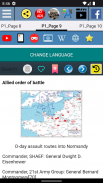










D-Day History

คำอธิบายของD-Day History
In the military, D-Day is the day on which a combat attack or operation is to be initiated. The best known D-Day is during World War II, on June 6, 1944—the day of the Normandy landings—initiating the Western Allied effort to liberate mainland Europe from Nazi. However, many other invasions and operations had a designated D-Day, both before and after that operation.
The terms D-Day and H-Hour are used for the day and hour on which a combat attack or operation is to be initiated. They designate the day and hour of the operation when the day and hour have not yet been determined, or where secrecy is essential. For a given operation, the same D-Day and H-Hour apply for all units participating in it. When used in combination with numbers, and plus or minus signs, these terms indicate the point of time preceding or following a specific action. Thus, H−3 means 3 hours before H-Hour, and D+3 means 3 days after D-Day. (By extension, H+75 minutes is used for H-Hour plus 1 hour and 15 minutes.) Planning papers for large-scale operations are made up in detail long before specific dates are set. Thus, orders are issued for the various steps to be carried out on the D-Day or H-Hour minus or plus a certain number of days, hours, or minutes. At the appropriate time, a subsequent order is issued that states the actual day and times.
Other days such as A-Day (Battle of Leyte), L-Day (Battle of Okinawa) etc. have different meanings for the military.
Other languages have terms equivalent to D-Day such as "Hari H" (Indonesian),Час Ч (Russian), Dagen D[citation needed] (Swedish), Dan D (Slovenian), E eguna (Basque), Jour J (French), Lá L (Irish), Tag X (German), and Ziua-Z (Romanian). The initial D in D-Day has been given various meanings in the past, while more recently it has obtained the connotation of "Day" itself, thereby creating the phrase "Day-Day", or "Day of Days".
ในการทหาร, D-Day เป็นวันที่มีการโจมตีการต่อสู้หรือการดำเนินงานคือการเริ่มต้น ที่รู้จักกันดี D-Day เป็นช่วงสงครามโลกครั้งที่สองเมื่อวันที่ 6 มิถุนายน 1944 เป็นวันที่ของเพลย์นอร์มั-เริ่มต้นความพยายามของฝ่ายพันธมิตรตะวันตกเพื่อปลดปล่อยแผ่นดินยุโรปจากนาซี อย่างไรก็ตามการรุกรานอื่น ๆ อีกมากมายและการดำเนินงานมีกำหนด D-Day ทั้งก่อนและหลังการดำเนินการที่
แง่ D-Day และ H-ชั่วโมงที่มีการใช้สำหรับวันและชั่วโมงที่โจมตีการต่อสู้หรือการดำเนินงานคือการเริ่มต้น พวกเขากำหนดวันและชั่วโมงของการดำเนินการเมื่อวันและชั่วโมงยังไม่ได้รับการพิจารณาหรือที่เป็นความลับเป็นสิ่งจำเป็น สำหรับการดำเนินงานที่กำหนด D-วันเดียวกันและ H-ชั่วโมงใช้สำหรับทุกหน่วยงานที่เข้าร่วมโครงการในนั้น เมื่อนำมาใช้ร่วมกับตัวเลขและสัญญาณบวกหรือลบคำเหล่านี้แสดงให้เห็นจุดของเวลาก่อนหน้านี้ต่อไปหรือการกระทำที่เฉพาะเจาะจง ดังนั้น H-3 หมายถึง 3 ชั่วโมงก่อนที่ H-ชั่วโมงและ D + 3 หมายถึง 3 วันหลังจาก D-Day (โดยส่วนขยาย, H + 75 นาทีจะใช้สำหรับ H-ชั่วโมงบวก 1 ชั่วโมงและ 15 นาที.) เอกสารการวางแผนสำหรับการดำเนินงานขนาดใหญ่ที่ทำขึ้นในรายละเอียดนานก่อนวันที่มีการตั้งค่า ดังนั้นคำสั่งซื้อจะออกให้สำหรับขั้นตอนต่างๆที่จะดำเนินการใน D-Day หรือลบ H-ชั่วโมงหรือบวกจำนวนหนึ่งของวันชั่วโมงหรือนาที ในเวลาที่เหมาะสมเป็นลำดับถัดลงมาจะออกที่ระบุวันและเวลาที่เกิดขึ้นจริง
วันอื่น ๆ เช่น A-Day (เตรบ), L-Day (ยุทธภูมิโอกินาวา) เป็นต้นมีความหมายที่แตกต่างกันสำหรับทหาร
ภาษาอื่น ๆ ที่มีเงื่อนไขที่เทียบเท่ากับ D-Day เช่น "ฮาริ H" (อินโดนีเซีย) ЧасЧ (รัสเซีย) Dagen D [อ้างจำเป็น] (สวีเดน), แดน D (สโลวีเนีย) E eguna (บาสก์) Jour J ( ฝรั่งเศส), LA L (ไอร์แลนด์), X แท็ก (เยอรมัน) และ Ziua-Z (โรมาเนีย) ม D เริ่มต้นในการ D-Day ได้รับความหมายต่าง ๆ ในอดีตที่ผ่านมาในขณะที่เมื่อเร็ว ๆ นี้จะได้รับความหมายของ "วัน" ของตัวเองดังนั้นการสร้างวลี "วันวัน" หรือ "วันวัน"




























